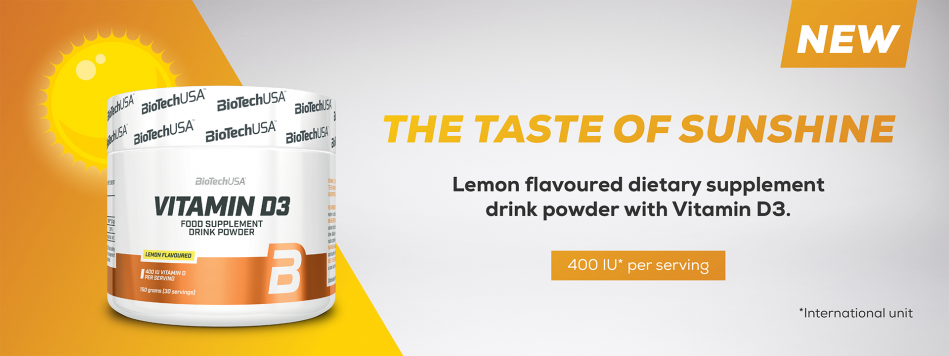
Vitamin D and how to avoid its deficiency

Vitamin D is the most common nutritional deficiency worldwide, and from the UK’s population, 1 in 5 people suffer from it, rising to almost one third of the population during the winter months. This underrated vitamin is found in certain foods but is also produced by the body in response to exposure to the sun.
The benefits of Vitamin D include:
- Helping healthy bones and teeth
- Associated with immune, brain, and nervous system health
- Adjusting insulin levels and supporting diabetes management
- Assisting lung function and cardiovascular health
- Affecting the expression of genes involved in cancer development
In this article we break down this important micronutrient in your body.

Vitamin D has a number of benefits
Maintains healthy bones and teeth
If your body doesn’t get enough vitamin D, you’re at risk of developing bone abnormalities such as soft bones (osteomalacia) or fragile bones (osteoporosis). People need vitamin D to allow the intestines to stimulate and absorb calcium and reclaim calcium that the kidneys would otherwise excrete. These factors are vital for maintaining healthy bones.
Vitamin D deficiency comes with poor bone density and muscular weakness, which can be critical for everyone but specially to those who want to lift heavy for muscle mass gain. On the other hand, Calcium is key for healthy jawbones and, as consequence, keeping the teeth in place.
Supports the immune system
The immune system is responsible to defend the body from foreign, invading organisms, promoting protective immunity while maintaining tolerance to self. Vitamin D contributes to the strengthening this system and low vitamin D levels are associated with an increased incidence of upper respiratory tract infections.
There are Vitamin D receptors and activating enzymes on the surfaces of all White Blood Cells. The role that vitamin D plays in keeping the immune system healthy is very complex because the immune system has to be perfectly balanced. If there is too much stimulation, autoimmune diseases can set in. If there is not enough immune system activity, frequent infections can occur. Low levels of vitamin D have been linked with both extremes
Reduces the risk of diabetes and supports weight loss
Vitamin D is believed to help improve the body’s sensitivity to insulin – the hormone responsible for regulating blood sugar levels – and thus reduce the risk of insulin resistance, which is often a precursor to type 2 diabetes.
When it comes to weight loss, vitamin D can increase your body’s levels of the hormone lepti, which controls body fat storage and triggers the sensation of satiety, giving the feeling of having eaten enough and thus lowering hunger levels.
It’s also believed that vitamin D improves insulin sensitivity by activating other receptors that help regulate the metabolism of fatty acids within muscle and body fat.
Here’s how you can take in vitamin D
3 sources of vitamin D: sunbathing, nutrition and dietary supplements.
Vitamin D is more than just one vitamin. It’s a family of nutrients that shares similarities in chemical structure. In your diet, the most commonly found members are vitamin D2 and D3. While both types help you meet your vitamin D requirements, they differ in a few important ways.
Your skin produces vitamin D when it’s exposed to sunlight. However, if you spend most of your time indoors or live at high latitude, you’ll need to get this vitamin from your diet.
1. The two forms of vitamin D differ depending on their food sources.
Vitamin D3 is only found in animal-sourced foods, whereas D2 mainly comes from plant sources and fortified foods.
Sources of Vitamin D3
- Oily fish and fish oil
- Liver
- Egg yolk
- Butter
- Dietary supplements
Sources of Vitamin D2
- Mushrooms (grown in UV light)
- Fortified foods
- Dietary supplements
2. Here are 9 healthy foods that are high in vitamin D
The Reference Daily Intake (RDI) is 600 IU of vitamin D per day from foods. The recommended daily amount of vitamin D is 400 international units (IU) for children up to age 12 months, 600 IU for ages 1 to 70 years, and 800 IU for people over 70 years.
Salmon: Wild salmon contains about 988 IU of vitamin D per serving, while farmed salmon contains 250 IU, on average. That’s 165% and 42% of the RDI, respectively.
Herring and sardines: Herring contains 1,628 IU of vitamin D per 3.5-ounce (100-gram) serving. Pickled herring, sardines and other fatty fish, such as halibut and mackerel, are also good sources.
Cold liver oil: Cod liver oil contains 450 IU of vitamin D per teaspoon (4.9 ml), or 75% of the RDI. It is also high in other nutrients, such as vitamin A and omega-3 fatty acids.
Canned tuna: Canned tuna contains 236 IU of vitamin D per serving. Choose light tuna and eat 6 ounces (170 grams) or less per week to prevent methylmercury buildup.
Oysters: Oysters are full of nutrients and provide 53% of the RDI for vitamin D. They also contain more vitamin B12, copper and zinc than a multivitamin.
Shrimp: Shrimp provide 152 IU of vitamin D per serving and are also very low in fat. They do contain cholesterol, but this is not a cause for concern.
However, it may be difficult to get adequate amounts of this vitamin from your diet alone, as rich natural sources are rare. For these reasons, it’s common for people to not get enough. Luckily, many food manufacturers add it to their products, especially milk, margarine and breakfast cereals. Supplements are also popular.
But you must be careful with supplements, the European Food Safety Authority (EFSA) reviewed safe levels of intake in 2012, setting the tolerable upper limit for adults at 100 μg/day (4000 IU), a similar conclusion as the Institute of Medicine. If you take vitamin D supplements, make sure not to exceed the safe upper intake level, which is 4,000 IU (100 micrograms) per day for adults.
3. Sunbathing
Most people meet at least some of their vitamin D needs through exposure to sunlight. However, despite the importance of the sun for vitamin D synthesis, it is recommended to limit exposure of skin to sunlight and UV radiation from tanning beds because of the damages it can cause to the skin.
Taken responsibly, there’s no risk of your body making too much vitamin D from sun exposure, but always remember to cover up or protect your skin before the time it takes you to start turning red or burn.
In the winter, it’s virtually impossible to produce vitamin D from the sun depending on where you live, because the sun never gets high enough in the sky for its ultraviolet B rays to penetrate the atmosphere, according to Harvard Womens’ Health Watch. But summer is a great time to stock up on the nutrient in your liver and fat. When the sun’s UV-B rays hit the skin, a reaction takes place that enables skin cells to manufacture vitamin D.
4. Supplements
Everyone over the age of 5 years (including pregnant and breastfeeding women) is advised to consider taking a daily supplement containing 10 micrograms (μg) of vitamin D.
Vitamin supplements are available over-the-counter, including BioTechUSA’s Vitamin D3 supplements, specially designed to support your daily intake of this macronutrient:
Vitamin D3 drink: A lemon flavoured dietary supplement powder drink with Vitamin D3 and sweeteners. With 10 µg Vitamin D3 per serving.
Vitamin D3 tablets: Compressed tablets containing 50 µg Vitamin D3 per serving. Should be taken daily with a large glass of water.
In summary, Vitamin D plays a key role in your body whether you are into fitness or not. The deficiency of this vitamin can be the cause of health issues with your bones and muscular strength, even affecting your jaw and how it holds onto your teeth. Fortunately, staying on track is as easy as spending some daily time exposing your body to direct sun light and adding certain foods to your regular diet. Also, there are supplements in the market that will contribute to supply the missing amount of vitamin D, supporting you to reach the goal of 100 μg/day.
